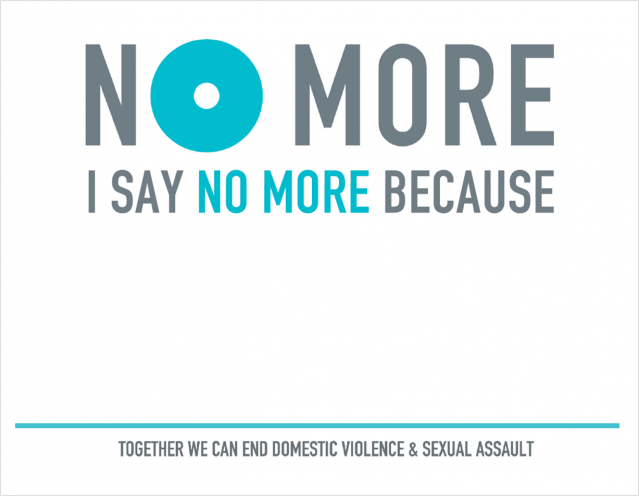Sexual Abuse
On the Confusion Between Sexual Fantasy and Reality
Do media images of submissive women deaden us to the reality of sexual violence?
Posted December 4, 2014

Used by permission: nomore.org
Friday Nov 28, 2014
Columnist Nicholas Kristoff's article, Bill Cosby, U.V.A. and Rape in the op-ed section of last Thursday's New York Times made the important point that we have a long way to go in confronting sexual assault. Indeed, we often rationalize, make excuses for, and just plain ignore sexual violence.
In Kristoff's words, "The larger problem is a culture that enables rape. The larger problem is us." According to an inspector-general report in New Orleans quoted by Kristoff, only 14% of sexual assault cases referred to a victims unit end up being investigated. According to the White House, 20% of female college students are the victims of sexual violence. But few rapists on college campus ever face any consequences.
"How thin our veneer of civilization is," Kristoff wrote. "The problem . . . isn't just one university, but the broader culture. It's ubiquitous."
It was hard not to ponder this broader culture on turning the page after reading Kristoff's article.
On the next page (page A36, for any of you who still haven't thrown out last Thursday's Times), there was an advertisement for a women's fashion house. The ad showed a beautiful young women dressed only in a sweater, reclining on a couch behind some gift boxes presumably full of clothing. Her hair was tossed over one eye.
I couldn't quite decipher the expression on her face—because there was really no expression at all. Her face had no amination or tone. Just a blankness—a passivity.
She did not look happy. Maybe it was because I had just read the Kristoff article, which referred to the accusations that Bill Cosby drugged and raped many women, but I couldn't help thinking she looked as if she may have been drugged. The hair covering half her face—what was it hiding? Where were the rest of her clothes? Who had them?
For anyone who has ever seen a fashion magazine, there would have been nothing exceptional about the look on this women's face. Fashion images very often adopt this look. As I read it, it says, "I'm confused. I'm helpless. Do with me what you will."
It's a look that's so familiar that I wouldn't even have noticed it, were it not for the Kristoff article on the page before. But this one fashion model's unhappy, submissive look—juxtaposed against an article about how society rationalizes sexual assault—reminded me how images of sexual submission are ubiquitous in the media. There's obviously a big difference between sexual surrender and sexual assault. But still it was jarring to see Kristoff's article right by this image of a woman who looked drugged.
We see so many images of women in poses of erotic surrender. I couldn't help wondering if they might have some role in deadening us to the reality of sexual violence in our midst—or suggesting to some men that sex without a woman's consent might be OK.
Surely it would be better if these images of women in submissive poses were to stop. But that's not likely to happen—because sex sells, and people seem to find submissiveness sexy.
I'm obviously not the first to wonder why submission and surrender often work as erotic fantasy. Psychoanalyst Jessica Benjamin wrote a whole book, The Bonds of Love, wondering why -- and never came to a satisfactory conclusion.
Maybe it's something hard-wired in us. Maybe it's the product of centuries of women's oppression and lack of power. Or perhaps it's a lingering cultural memory of millennia past, before there were institutions intended to prevent women being taken by force. The words "raped" and "ravished" originally had the same meaning.
"Too often boys are socialized to see women and girls as baubles, as playthings," writes Kristoff. I disagree. I don't think it's just socialization. I think it's something darker. Kristoff's phrase repeats in my mind: "How thin our veneer of civilization is." I wonder if sexual assault might be part of our deep heritage as a species, just as it is for some of our nearest ape relatives.
Humanity's roots are undeniably violent. We don't get very far into Genesis before Cain murders Abel in Chapter 4, and sexual assault is right around the corner in Chapters 19 and 34. As a civilization, we've done much to protect ourselves against murder and rape. But as Kristoff reminds us, we have a long way to go regarding the latter.
Happily we have now advanced to the point where most of us can clearly distinguish between fantasies of sexual surrender and the reality of rape. It's an important moment in the evolution of our society when people organize to say "No More." This is definitely progress.
The fact that the NFL is involved is a good thing too. We need men to clearly draw boundaries of acceptable behavior for other men.
In the meantime, it's likely we'll continue to see endless images of sexual submission and surrender in the media. Which is unfortunate, since this may dilute the message that sex without consent is always wrong.
© Stephen Snyder, MD 2014
www.sexualityresource.com
New York City




